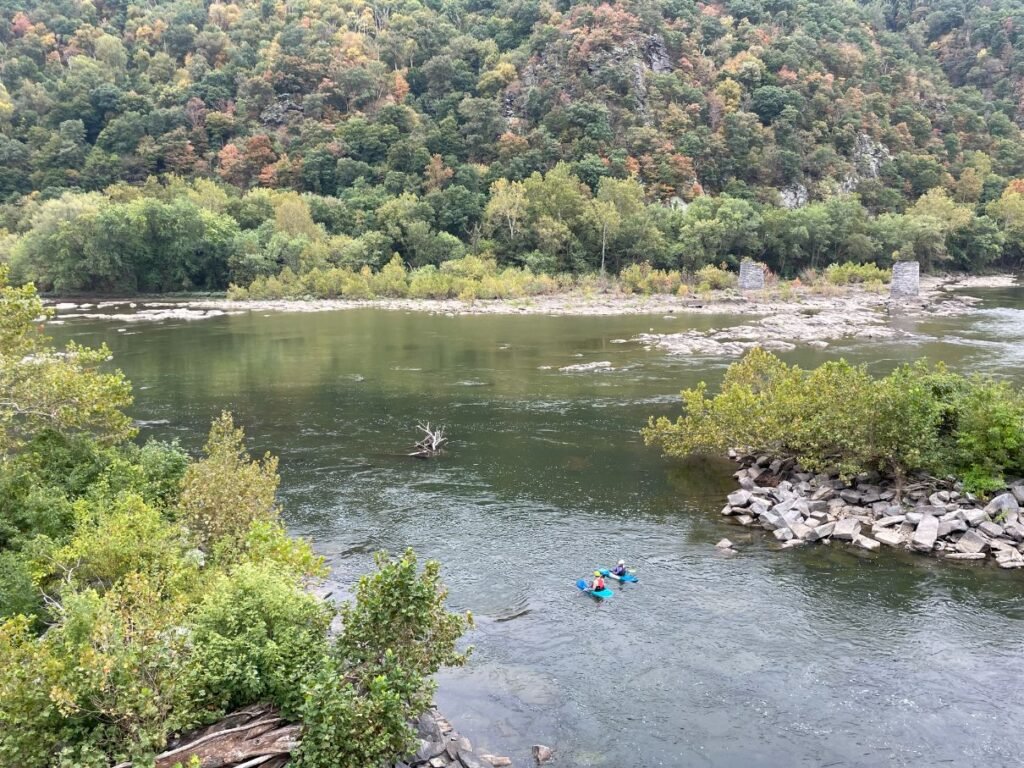
Encounter the past as you explore Harpers Ferry National Historical Park

Beyond knowing the basics about John Brown and Harpers Ferry, I had little knowledge of this West Virginia town and its historic significance. Road tripping through the state on my way to visit New River Gorge National Park, I saw that I could take an easy detour to explore the area. Glad I did, as it was an eye-opening experience and a worthwhile diversion.
I headed to the main entrance of Harpers Ferry National Historical Park and proceeded to get some info at the visitor center before hopping on a shuttle to Lower Town District. This was once the commercial heart of Harpers Ferry and includes some of the best historic structures remaining today. It is these sites that make it among one of the most beautifully preserved historic small towns in the country.
You’ll instantly be transported back to the past upon arriving in this quaint little hamlet. Victorian homes and 150-year-old row buildings with colorful rooftops line the streets. Living history museums that replicate life in the 1800s are interspersed between cute cafes and historically themed specialty shops. Walking trails abound in and around town, while the rolling Blue Ridge Mountains and rushing waters of the Shenandoah and Potomac Rivers bring the natural beauty of Appalachia to the scene.


Historic Lower Town buildings
Step into the living history museums to learn about Harpers Ferry before, during and after the Civil War. It might surprise you to discover that the town was one of the first industrial cities in the country. Three thousand people lived and worked in this prosperous hub, which benefited from a bounty of natural resources and a prime location at the confluence of the Potomac and Shenandoah Rivers. Its largest source of industry, the U.S. Armory, boasted over twenty factory buildings and had several hundred employees. And then there was the Baltimore and Ohio Railroad and the Chesapeake and Ohio Canal that provided a continuous flow of people and business throughout the town. These factors made Harpers Ferry strategically important to both sides during the Civil War.
The Industry Museum, for example, showcases transportation improvements and industrial innovations that were mainly responsible for Harpers Ferry’s prosperity. On display are original machines featuring weapons production technology. And at Arsenal Square, the Small Arsenal and Large Arsenal brick buildings you can see were used to store weapons produced at the Armory.

Confederates win a major battle at Harpers Ferry

Confluence

Harpers Ferry and the Road to Emancipation

Access the App Trail from here

Harpers Ferry documented in detail
Over in Frankel’s Clothing Store, exhibits reveal a revolution in the clothing industry tied to machines and advanced by the war. While in the Dry Goods Store, clothes, hardware, groceries, liquor that once arrived by railroad and canal sit on the shelves.
Nearby is the Blacksmith Shop, the ever-essential business in any town back then. And to get a look at where people stayed when coming to Harpers Ferry, check out Mrs. Stipes Boarding House.
At the Provost Marshal Office, you’ll learn about the man who served as judge, jailer and when necessary, executioner. A powerful position, no doubt!
John Brown’s history takes centerstage at the John Brown Museum and John Brown Fort. Most people will recall that John Brown was a radical abolitionist leader, who raided Harpers Ferry to start an armed slave revolt and ultimately end slavery. He believed that violence was necessary to achieve his goal after decades of peaceful efforts had failed to come to fruition.
On October 16, 1859, Brown and eighteen men, including five African Americans, seized control of the U.S. Armory in town, which had a stockpile of around 100,000 weapons. The raid was short lived as soon after, local militias surrounded the area and on the orders of President James Buchanan, Colonel Robert E. Lee and his unit entered the scene to put an end to the situation. Lee, as we know, went on to play a major role as a Confederate General in the coming Civil War.

John Brown’s Fort courtesy of NPS

Jefferson’s Rock

Kayakers paddling the river at the start of fall colors

Museum exhibits go into depth about the town and John Brown

Living history museums interspersed among stores and cafes
John Brown was subsequently captured in the Harpers Ferry engine house, while ten of his men died in the fray, two of whom were Brown’s sons. Brown, who was charged and convicted of treason, murder and conspiring with slaves to rebel, was sentenced to death by hanging. Interesting to learn that among those present at his execution were Stonewall Jackson, John Wilkes Booth and Edmund Ruffin; the latter who fired one of the first shots of the Civil War at Fort Sumter.
Brown’s trial and execution spotlighted the issue of slavery and propelled the nation towards civil war. For Southerners at the time, he stood as a powerful symbol of aggressive Northern antislavery sentiment and, as a white man willing to die to end slavery, he was “the embodiment of their fears.” To others, he was viewed as a hero, a martyr and the “harbinger of the future.” And then there were those who simply wrote him off as a madman.
As for John Brown’s Fort, it was originally the Armory’s fire engine house and watchman’s office, but its claim to fame is its use by Brown, who barricaded himself there during the last moments of his raid. Then during the Civil War, it served as a prison, a powder magazine and supply house. It was the only Armory building to escape destruction during the war.
Battles for control over Harpers Ferry waged on through the Civil War. It changed hands numerous times over the years, though the Union held it in its grasp for a majority of the period. The well-known Battle of Harpers Ferry in 1862, however, was a decisive win for the Confederacy. Forces under General Stonewall Jackson besieged the 12,000-man garrison in town, resulting in the largest surrender of American troops until WWII.

Walk across the bridge into Maryland

The Point

St. Peter’s Roman Catholic Church

The Civil War devastated the town

Provost Marshall’s office
Postwar, Harpers Ferry took on a very different role, particularly for African Americans as they pursued better lives, education and equality under the new laws in America. Of particular note is Storer College. What began as a one-room school for former slaves grew into a college open to both sexes and all races. It survived for 88 years, enriching the lives of thousands of students.
For scenic overlooks, head up to Thomas Jefferson’s Rock. You’ll take an ancient, moss-spotted staircase and on the way up, you’ll pass St. Peter’s Roman Catholic Church. This 1833 Victorian Gothic structure sports stained-glass windows, a dramatic spire and stone exterior. It, like the Armory, was spared significant damage during the Civil War.
Stop in for a peek, then proceed on the footpath, which leads up to Thomas Jefferson’s Rock. This beautiful spot is where the former U.S. president famously declared the landscape “worth a voyage across the Atlantic.”
Another scenic locale accessed from town is The Point, where the Shenandoah and Potomac Rivers meet. You can actually see the V-shaped gap in the water designating this place. Here you can look upon three states – Maryland, Virginia and West Virginia. And you can walk across Harpers Ferry Railroad Bridge, which connects the Appalachian Trail from West VA to MD. Once on the other side, you’ll be able to access the Chesapeake & Ohio Canal National Historic Park where the C&O Canal Towpath is located. If you’re up for a lengthy trek, the path is 184.5 miles long and goes from Georgetown to Cumberland, MD.

Map of Lower Town, courtesy of NPS



































